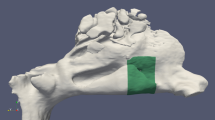Abstract
In this study we utilized computational fluid dynamic (CFD) techniques to construct a numerical simulation of nasal cavity airflow pre and post virtual functional endoscopic surgery (FESS). A healthy subject was selected, and CFD techniques were then applied to construct an anatomically and proportionally accurate three-dimensional nasal model based on nasal CT scans. A virtual FESS intervention was performed numerically on the normal nasal model using Fluent software. Navier-Stokes and continuity equations were used to calculate and compare airflow, velocity, distribution and pressure in both the pre and post FESS models. In the post-FESS model, there was an increase in airflow distribution in the maxillary, ethmoid and sphenoid sinuses, and a 13% increase through the area connecting the middle meatus and the surgically opened ethmoid. There was a gradual decrease in nasal resistance in the posterior ethmoid sinus region following FESS. These findings highlight the potential of this technique as a powerful preoperative assessment tool to aid clinical decision-making.





Similar content being viewed by others
References
Belleman RG, Sloot PMA (2001) Simulated vascular reconstruction in a virtual operating theatre. In: Lemke HU, Vannier MW, Inamura K, Farman AG, Doi K (eds) Computer assisted radiology and surgery (Excerpta Medica, International Congress Series1230). Elsevier, Berlin, pp 938–944
Cant S (2002) High-performance computing in computational fluid dynamics: progress and challenges. Philos Transact A Math Phys Eng Sci 360:1211–1225
Courtiss EH, Goldwyn RM (1983) The effects of nasal surgery on airflow. Plast Reconstr Surg 72:9–21
Croce C, Fodil R, Durand M et al (2006) In vitro experiments and numerical simulations of airflow in realistic nasal airway geometry. Ann Biomed Eng 34:997–1007. doi:10.1007/s10439-006-9094-8
Girardin M, Bilgen E, Arbour P (1983) Experimental study of velocity fields in a human nasal fossa by laser anemometry. Ann Otol Rhinol Laryngol 92:231–236
Hahn I, Scherer PW, Mozell MM (1993) Velocity profiles measured for airflow through a large-scale model of the human nasal cavity. J Appl Physiol 75:2273–2287
Hornung DE, Leopold DA, Youngentob SL et al (1987) Airflow patterns in a human nasal model. Arch Otolaryngol Head Neck Surg 113:169–172
Horschler I, Meinke M, Schroder W (2003) Numerical simulation of the flow field in a model of the nasal cavity. Comput Fluids 32:39–45. doi:10.1016/S0045-7930(01)00097-4
Keyhani K, Scherer PW, Mozell MM (1995) Numerical simulation of airflow in the human nasal cavity. J Biomech Eng 117:429–441. doi:10.1115/1.2794204
Keyhani K, Scherer PW, Mozell MM (1997) A numerical model of nasal odorant transport for the analysis of human olfaction. J Theor Biol 186:279–301. doi:10.1006/jtbi.1996.0347
Ku JP, Draney MT, Arko FR et al (2002) In vivo validation of numerical prediction of blood flow in arterial bypass grafts. Ann Biomed Eng 30:743–752. doi:10.1114/1.1496086
Martonen TB, Quan L, Zhang Z, Musante CJ (2002) Flow simulation in the human upper respiratory tract. Cell Biochem Biophys 37:27–36. doi:10.1385/CBB:37:1:27
Proctor DF (1982) The upper airway. In: Proctor DF, Anderson IB (eds) The nose: upper airway physiology and the atmospheric environment.Elsevier, New York, pp 23–42
Proetz AW (1952) Air currents in the upper respiratory tract and their clinical importance. Trans Am Laryngol Rhinol Otol Soc 53:73–103
Subramaniam RP, Richardson RB, Morgan KT, Kimbell JS (1999) Computational fluid dynamics simulations of inspiratory airflow in the human nose and nasopharynx. Inhal Toxicol 10:91–120. doi:10.1080/089583798197772
Taylor CA, Draney MT, Ku JP et al (1999) Predictive medicine: computational techniques in therapeutic decision-making. Comput Aided Surg 4:231–247
Wang K, Denney T, Morrison E, Vodyanoy V (2005) Numerical simulation of air flow in the human nasal cavity. Conf Proc IEEE Eng Med Biol Soc 6:5607–5610
Zhao K, Pribitkin EA, Cowart BJ, Rosen D, Scherer PW, Dalton P (2006) Numerical modeling of nasal obstruction and endoscopic surgical intervention: outcome to airflow and olfaction. Am J Rhinol 20:308–316. doi:10.2500/ajr.2006.20.2848
Acknowledgments
This research was supported by grant number 5010 from the Clinical Medicine Research board of Sun Yat-Sen University.
Author information
Authors and Affiliations
Corresponding author
Rights and permissions
About this article
Cite this article
Xiong, G., Zhan, J., Zuo, K. et al. Numerical flow simulation in the post-endoscopic sinus surgery nasal cavity. Med Biol Eng Comput 46, 1161–1167 (2008). https://doi.org/10.1007/s11517-008-0384-1
Received:
Accepted:
Published:
Issue Date:
DOI: https://doi.org/10.1007/s11517-008-0384-1




